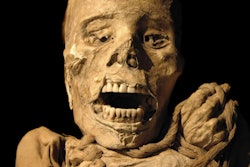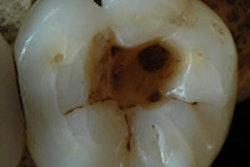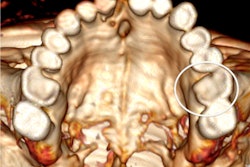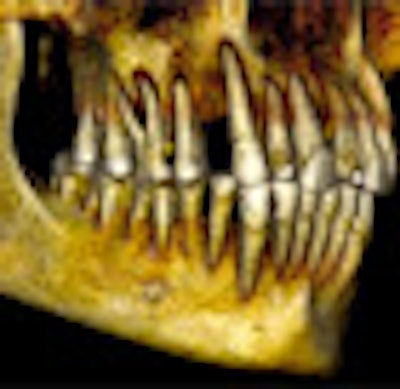
Just in time for Halloween ... High-resolution CT has given researchers a better look at a unique dental intervention previously discovered in a mummy that is thousands of years old. Their findings provide evidence of dental specialists practicing in ancient Egypt.
For the past several decades, CT has enabled researchers to examine mummies without damaging the remains and study ancient mummification processes, as well as the humans' health status -- including dental condition -- at the time of death.
Now researchers have used multidetector-row CT to image the mummies from the Redpath Museum at McGill University in Montreal. The dental findings of one male mummy in particular piqued the researchers' interest for further study as the CT images show a unique example of early dental intervention in ancient Egypt (International Journal of Paleopathology, October 3, 2012).
The mummy had "dental packing of a large interproximal carious lesion with a protective linen barrier," the researchers reported. "The dental packing ... is unique among ancient Egyptian mummies studied to date, and represents one of only a few recorded dental interventions in ancient Egypt," lead author Andrew D. Wade, PhD, and colleagues wrote. "Such a finding lends further support for the existence of a group of dental specialists practicing interventional medicine in ancient Egypt."

Click image to enlarge.
RM2718 gets placed in the CT scanner at the Montreal Neurological Institute and Hospital. Image courtesy of Nicholas Morin.
Wade has a doctorate in archaeological sciences and is a research fellow in the anthropology department at the University of Western Ontario. His research involves "medical imaging of mummies and skeletons, and analyzing their remains to learn more about people, societies, and diseases in the past," Wade wrote on his blog, "Are You My Mummy?"
Wade is also the database administrator for the international Internet-based Mummy Picture Archive and Communication Technology (IMPACT) Radiological Mummy Database at the university. The database is a multi-institutional collaborative research project devoted to the study of mummified remains using nondestructive medical imaging technologies.
Ancient dentistry 101
Ancient and classical texts indicate the existence of a dental profession that attempted to ease the pain and discomfort of dental disease, according to the study authors. Ancient toothache remedies included bitumen, cedar oil, wild olive gum, and fig juice on wool inserted into the cavity -- and, of course, extraction. Egyptian medical texts mention other dental remedies, including preventing tooth loss and how to "fasten a tooth" with ochre, honey, frankincense, and malachite.
Later the Greeks and Romans described filling materials and methods that included shredded alum wrapped in wool and inserted into the cavity, or filling with lint or lead and extracting the tooth.
RM2718 undergoes a whole-body CT scan. Image courtesy of Nicholas Morin.
','dvPres', 'clsTopBtn', 'true' );" >
Click image to enlarge.
RM2718 undergoes a whole-body CT scan. Image courtesy of Nicholas Morin.
There are examples of prostheses, but the authors stated that there is "serious doubt over their use in the lifetime of the individual, and these may represent embalming prostheses intended to restore the natural form of the mummy for its use in the afterlife," just as other body parts were repaired or replaced by embalmers.
While dental remedies are described in ancient texts, little physical evidence exists of interventional dental practices, making the Redpath Museum mummy with dental packing an interesting case study, the authors noted.
Imaging and radiocarbon dating
The mummy, known as the Theban Male (RM2718), is a young adult male that was acquired by Montreal politician James Ferrier during a trip to Egypt in 1859, according to co-author Barbara Lawson, curator of world cultures at the Redpath Museum.
In 1995, the mummy was imaged using plain film radiographs and CT with 3-mm slice thickness. His teeth were later examined by Odin Langsjoen, DDS, of the University of Minnesota-Duluth. "A dense rounded mass was noted in the largest of the carious lesions, which indicated that the individual may have received medical treatment during life," the authors reported.
In April 2011, the museum's mummy collection, which included two other female human mummies, was reimaged with higher-resolution CT as part of the IMPACT project. Wade and colleagues reported their findings of all three mummies earlier this year (RadioGraphics, July-August 2012, Vol. 32:4, pp. 1235-1250). They estimated the male mummy's age at death to be 20 to 30 years based on dental eruption and skeletal features.
|
Video from 3D reconstruction CT images of the dental packing in the left first and second molars. Video courtesy of the International Journal of Paleopathology. |
The whole-body CT scans were performed at the Montreal Neurological Institute and Hospital using an Aquilion One 320-slice scanner (Toshiba America Medical Systems) with 0.5-mm-thick slices, offering much greater detail than the CT imaging performed in 1995 and also the ability to create 3D reconstructions, using Vital Images' Vitrea software and OsiriX software.
"We wanted to look closer at the dental packing because it is unique, so far, in published accounts of mummified human remains from Egypt," Wade wrote in an email to DrBicuspid.com. "We wanted to showcase the power of the recent scanning technology, too, in the hopes that more rescanning is done on mummies. CT scans from the '90s were great at the time, but we've come a long way in terms of spatial resolution."
In addition, in the fall of 2011, the mummy's outer linen wrapping underwent radiocarbon analysis, which dated the mummy as being from the Ptolemaic Period at approximately 350-360 before the common era (BCE) -- much younger than the New Kingdom Period (1550-1069 BCE) previously thought based on the museum's records.
Curved planar reformatted CT image. Note the carious lesions on the left first and second molars. Image courtesy of Andrew D. Wade, PhD.','dvPres', 'clsTopBtn', 'true' );" >
Click image to enlarge.
Curved planar reformatted CT image. Note the carious lesions on the left first and second molars. Image courtesy of Andrew D. Wade, PhD.
|
Multiplanar reformatted CT slices showing the packing material in the large interproximal carious lesion. Image courtesy of the International Journal of Paleopathology.','dvPres', 'clsTopBtn', 'true' );" >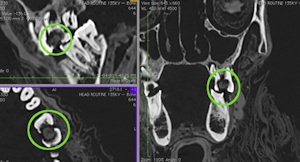
Click image to enlarge.
|
| Multiplanar reformatted CT slices showing the packing material in the large interproximal carious lesion. Image courtesy of the International Journal of Paleopathology. |
Dental findings
Overall, the dental condition of the mummy is poor, the researchers reported. The maxillary and mandibular teeth show occlusal attrition and abrasion, while the maxillary teeth also have numerous periapical abscesses and large interproximal carious lesions.
"Abscesses were found at the apices of the maxillary right first molar and second incisor and of the left first incisor and molars," they wrote. "The abscesses of the left maxillary molars communicate with the maxillary sinus and inferior meatus. Interproximal caries are noted in the maxillary right second premolar."
In fact, the dental condition of the young man may have caused his death. "An infection, such as that seen here extending into the sinuses, was likely accompanied by substantial pain and swelling during the life of this individual, and may have ultimately led to his death," Wade and colleagues wrote.
The researchers also identified the mass previously found by Dr. Langsjoen in the carious lesions of the left first and second molars, and described it as a low-density, homogeneous ball of material, such as linen. It measures 7.7 x 7.1 x 3.7 mm, larger than the lesion's opening of 5.5 x 6.8 mm, but it remains loose within the cavity, they noted.
The mass is evidence of "therapeutic dental packing" that was used before death, according to the authors. No antemortem dental packing has been identified before, and this wasn't done postmortem, as the mass was not formed to the tooth's shape for a lifelike appearance and function in the afterlife, and not all of the cavities are filled, they explained. Also, the material wouldn't have been able to restore strength or stability to the tooth. But it may have delivered a medicine such as cedar oil or fig juice to treat the pain, prevented food particles from entering the cavity, and protected the nerve from contact with the tongue or foreign bodies, they noted.
The researchers also pointed out the unusual appearance of the maxillary left first and right second incisors, which are smooth and flat with the same chiseled shape. The pulp chambers of both are exposed anteriorly, but the incisor in between doesn't have the same damage.
Sweet tooth?
Heavy attrition and abrasion are the most common dental conditions of the ancient Egyptians, often resulting in periapical abscesses from the exposure of the pulp to bacteria, according to the researchers. The cause is due to the Egyptian diet, which consisted in large part of coarse-milled flour that was often mixed with millstone debris and sand from the desert, they noted.
"The heavy occlusal wear resulting from chewing these components is evident in both noble and commoner mummies throughout Egyptian history and even in modern Egyptian farmers," Wade and colleagues wrote. "While the high level of attrition serves to wear smooth the pits and grooves where cariogenic bacteria adhere, the high-carbohydrate component of the ancient Egyptian diet, including bread and a weak porridge-like beer, was still a cariogenic risk for nonocclusal surfaces."
3D reconstruction shows the worn incisors. Image courtesy of Andrew D. Wade, PhD.
','dvPres', 'clsTopBtn', 'true' );" >
Click image to enlarge.
3D reconstruction shows the worn incisors. Image courtesy of Andrew D. Wade, PhD.
Co-author and consulting dentist Dr. Jaana Hurnanen, of the department of forensic medicine at the Hjelt Institute at the University of Helsinki in Finland, took note of the difference between the conditions of the maxillary and mandibular teeth, according to Wade.
"Only the upper teeth have cavities or abscesses, and lots of them; the lower teeth are in fine shape for an ancient Egyptian," Wade wrote on his blog. "Given what we know about the effect of soft, sticky food on the teeth, our thought was that this man was eating something that he could keep isolated on the roof of his mouth. This would keep it off the lower teeth until it was swallowed and leave them in good shape." His theory was perhaps honey or some other soft, sticky, sugary food may have been eaten.
And what about the unusual wear pattern of the incisors? From the 1995 CT scans, it was believed that these teeth had been broken, but the condition of the incisors is consistent with antemortem slow wear of the surface, according to the authors. Since the ancient Egyptians weren't known for modifying the shape of their teeth and the attrition and abrasion wear pattern of ancient Egypt is occlusal in nature, the wear pattern of these incisors is not from mastication, but may be from using the teeth as tools of some sort, they noted.
 A work-in-progress facial reconstruction of RM2718. Image courtesy of forensic artist Victoria Lywood.
A work-in-progress facial reconstruction of RM2718. Image courtesy of forensic artist Victoria Lywood.
"The wear pattern doesn't correspond to anything we could find involving the use of the teeth as tools or as an extra hand," Wade wrote on his blog. "I came back to the honey idea, using each of those teeth at various times to remove honey (probably contaminated with wind-blown sand) from a thin spatulate utensil."
What's next for the Redpath mummies?
With the cranial and mandibular skeletal data from the recent CT scans, 3D printing was used to make solid, three-dimensional models, and forensic artist Victoria Lywood is creating facial reconstructions of the Redpath mummies to be displayed at the museum.
More research on the mummies will be published soon, according to Wade. "RM2718 and all of the Redpath mummies are a fascinating bunch," he told DrBicuspid.com. "And all of them are part of the IMPACT Radiological Mummy Database at Western, designed to make primary imaging datasets available online to researchers around the world."




